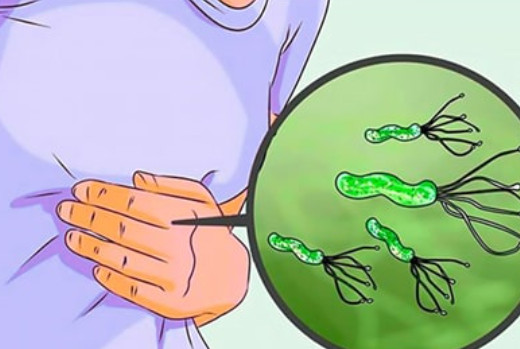
Introduction
Can H pylori cause skin diseases? The answer is (May be). Helicobacter pylori (H. pylori) is a gram negative bacteria, which affects about 50 % of the population across the world. H. pylori is considered one of the main causes of peptic ulcer and chronic gastritis. H. pylori infection usually occurs during childhood and in most cases without manifestations. If not treated H. pylori infection persists for a long time and may result in complications such as atrophic gastritis and gastric cancer. H. pylori may be transmitted from person to person through coming in contact with vomit, saliva or feces( fecal to oral) or ( oral to oral). Interpersonal contact among the family members is the main route of transmission.
What is the relationship between H. pylori infection and skin diseases?
H. pylori infection eradication was found to improve some patients complaining of chronic autoimmune urticaria, psoriasis, alopecia areata and Henoch -Schoenlein purpura. The relationship between H. pylori infection and autoimmune skin diseases is controversial and not well established and further studies are needed to confirm a casual relationship
What are the skin problems that may be associated with helicobacter pylori infection?
- Chronic urticaria.
- Rosacea.
- Psoriasis.
- Lichen planus.
- Henoch- Schönlein purpura.
- Behçet’s disease.
- Prurigo nodularis.
- Chronic cutaneous pruritus.
- Progressive systemic sclerosis.
- Sjögren’s syndrome.
- Sweet’s syndrome.
- Alopecia areata.
- Atopic dermatitis.
- Recurrent aphthous stomatitis.
- Autoimmune angioedema.
- Bullous pemphigoid.
- Dermatitis herpetiformis.
- Dermatomyositis.
- Eosinophilic fasciitis.
- Erythema nodosum.
- Pyoderma gangrenosum.
- Sarcoidosis.
- Reiter’s syndrome.
- Raynaud’s phenomenon.
- Undifferentiated connective tissue disease.
How H pylori causes skin diseases?
- It was found that H pylori infection may contribute to autoimmunity H. pylori chronic infection may result in antigen antibody complex formation , autoreactive antibodies or activates cross-reactive T cells.
- Microbial heat shock proteins are also similar to human heat shock proteins so they may be mistaken and attacked by the immune cells.
How to investigate for H. pylori infection?
- Urea breath test.
- Stool antigen test.
Treatment options of Helicobacter pylori infection
Clarithromycin triple therapy (susceptible to clarithromycin)
- Amoxicillin (1 g) and clarithromycin (500 mg) plus omeprazole 20 mg all given twice daily for 14 days.
Metronidazole triple therapy (susceptible to metronidazole)
- Amoxicillin (1 g) and metronidazole or tinidazole (500 mg) plus 20 mg omeprazole all given twice daily for 14 days.
Fluoroquinolone triple therapy (susceptible to fluoroquinolones)
- Levofloxacin 500 mg once daily, plus 20 mg omeprazole and amoxicillin 1 g twice daily for 14 days.
Susceptible to clarithromycin and metronidazole
- Clarithromycin (500 mg), and metronidazole or tinidazole (500 mg) plus 20 mg omeprazole all given twice daily for 14 days.
Resistant to clarithromycin (Bismuth quadruple therapy)
- Bismuth subsalicylate or bismuth subcitrate 2 tablets 2 or 4 times daily after meals plus tetracycline hydrochloride (500 mg) 4 times daily with meals and at bedtime plus metronidazole ( 500 mg) 3 times daily with meals and a PPI twice daily for 14 days.
Prepackaged bismuth quadruple therapy
- PYLERA for 14 days; add a PPI b.i.d. (20 mg to 40 mg omeprazole equivalent twice a day).
New bismuth quadruple therapy
- Bismuth 2 tablets 2 or 4 times daily after meals plus metronidazole (400 or 500 mg) four times daily with meals and amoxicillin 1 g three times daily along with a PPI (40 mg omeprazole equivalent or more twice a day) for 14 days.
- Bismuth 2 tablets 2 or 4 times daily after meals plus tetracycline HCl 500 mg four times daily with meals and amoxicillin 1 g three times daily along with a PPI (40 mg omeprazole equivalent or more twice a day) for 14 days.
Furazolidone quadruple therapy
- Furazolidone therapies are obtained by replacing metronidazole in bismuth quadruple therapies with furazolidone 100 mg three times daily.
Rifabutin triple therapy
- Rifabutin (150 mg once or twice daily), amoxicillin (1 g three times daily and omeprazole 40 mg (or an equivalent PPI) every 8 h for 14 days.
Bismuth Rifabutin therapy
- Add bismuth subcitrate or subsalicylate 2 tablets twice daily to above therapy.
How to avoid recurrence of H. Pylori infection ?
- Health education programs within the family (washing of hands and mouth, brushing teeth, no sharing of food plates or drinking glasses, no sharing of spoons in feeding children) should be implemented.
- Consider performing a urea breath test (UBT) 4-12 weeks after the end of treatment.
#H. pylori cause skin diseases #H. pylori chronic urticaria #H. pylori dermatology #H. pylori skin rash